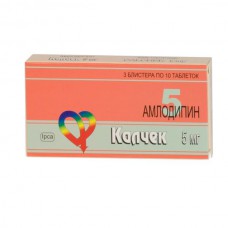Expiration date: 02/2026
Composition and form of issue:
Tablets, 1 tablet contains active substance:
besylate amlodipine equivalent amlodipine 5 or 10 mg
excipients: corn calcium starch hydrophosphate talc silicon dioxide colloidal sodium carboxymethyl starch magnesium stearate
blister aluminum foil/PVC film for 10 or 14 pieces per pack carton 2 blisters to 14 PCs. or 3 blisters on 10 PCs
Description of dosage form:
The tablets are flat with beveled edges, round shape, from white to almost white, with a risk on one side.
Pharmacokinetics:
After oral amlodipine is slowly absorbed (about 90%) from the gastrointestinal tract. Absolute bioavailability is 64-80%, Cmax in serum is observed after 6-9 h. Css achieved after 7-8 days of drug therapy. Eating does not affect the absorption of amlodipine. The average Vd is 21 l / kg body weight, indicating that most of the drug is in the tissues, and relatively less — in the blood. Most of the drug in the blood (97%) is bound to plasma proteins.
Amlodipine is metabolized in the liver to form inactive metabolites.
After a single intake of T1/2 is approximately 35 h. About 60% of an oral dose is excreted by the kidneys mainly as metabolites, 10% in an unmodified form, and 20-25% — in the bile through the intestines.
In patients with hypertension T1/2 — 48 h, in elderly patients (>65 years), the excretion of amlodipine slowed (T1/2 — 65 h) compared with young patients, but this boundary has no clinical significance.
In patients with hepatic insufficiency, lengthening T1/2 is assumed, and with long — term administration of the drug in the body will be higher (T1/2-up to 60 h).
Renal failure does not have a significant effect on the pharmacokinetics of amlodipine.
The drug penetrates the BBB. When hemodialysis is not removed.
Description of pharmacological action:
Amlodipine is a dihydropyridine derivative. By binding to dihydropyridine receptors, blocks slow calcium channels, inhibits transmembrane transition of calcium ions into smooth muscle cells of blood vessels (to a greater extent) and cardiomyocytes. It has a hypotensive and antianginal effect.
The mechanism of the hypotensive action of amlodipine is due to the direct relaxing effect on the smooth muscles of the vessels.
Amlodipine reduces myocardial ischemia in the following two ways:
- dilates arterioles and thus reduces peripheral vascular resistance (afterload), while heart rate remains practically unchanged, which leads to lower energy consumption and need of myocardium in oxygen
- dilates coronary and peripheral arteries and arterioles in both normal and ischemic areas of the myocardium, which increases the flow of oxygen to the myocardium in patients with vasospastic angina (princmetal angina) and prevents the development of coronary spasm caused by Smoking.
In patients with hypertension, a single daily dose of Kalchek provides a decrease in blood PRESSURE for 24 hours, both in the supine and standing position. Due to the slow onset of amlodipine does not cause a sharp decrease in blood PRESSURE.
In patients with angina pectoris, a single daily dose of the drug increases the time of physical activity, delays the development of another attack of angina and depression of the ST segment (by 1 mm) against the background of physical activity, reduces the frequency of angina attacks and the consumption of nitroglycerin.
The use in patients with coronary artery disease
In patients with cardiovascular disease (coronary atherosclerosis with lesions of a single vessel to the stenosis of 3 or more of the arteries and atherosclerosis of the carotid arteries), myocardial infarction, percutaneous transluminal angioplasty of coronary artery (TLP) or suffering from angina, the use of the drug, Calcic prevents the development of thickening of the intima-media complex of the carotid arteries, stroke, reduces the frequency of hospital admissions for the conduct of TLP, coronary artery bypass surgery and other interventions aimed at restoring coronary flow, and about unstable angina and the progression of chronic heart failure (CHF).
Use in patients with heart failure
Calcic does not increase the risk of fatal outcomes or complications in patients with CHF III–IV functional class (NYHA) during therapy with digoxin, diuretics and ACE inhibitors. In patients with CHF III–IV functional class NYHA nonischemic etiology in the use of the drug, Kalchik there is the likelihood of pulmonary edema. The drug Kalchek does not have any adverse effects on metabolism and plasma lipid concentration.
Indications:
- hypertension (monotherapy or combination with other antihypertensive drugs)
- stable angina, vasospastic angina Prinzmetal's angina (monotherapy or combination with other antihypertensive drugs).
Contraindications:
- hypersensitivity to amlodipine and/or other components of the drug and other derivatives of dihydropyridine
- severe hypotension (SBP <90 mm Hg.V.)
- unstable angina (except prinzmetals angina)
- pronounced stenosis of the aortic mouth
- the age of 18 years (efficacy and safety not established).
Caution: liver dysfunction, weakness syndrome sinusnogo node (expressed aetiology, tachycardia), chronic heart failure of nonischemic etiology (III–IV functional class NYHA classification), arterial hypotension, aortic stenosis, mitral stenosis, hypertrophic obstructive cardiomyopathy, acute myocardial infarction (and during the 1 month after), old age.
Use during pregnancy and breast-feeding:
The safety of amlodipine during pregnancy is not established, so the use during pregnancy is possible only if the benefit to the mother exceeds the risk to the fetus.
There is no evidence of amlodipine excretion in breast milk. However, it is known that other BCC (slow) — dihydropyridine derivatives are excreted in breast milk. If necessary, the appointment of amlodipine during lactation should decide on the termination of breastfeeding.
Side effect:
From the CCC: heartbeat, marked decrease in blood PRESSURE, peripheral edema (swelling of the ankles and feet) rarely — heart rhythm disorders (bradycardia, ventricular tachycardia, atrial flutter), myocardial infarction, chest pain, orthostatic hypotension, vasculitis is very rare — the development or exacerbation of heart failure, extrasystole, migraine.
From the Central nervous system: headache, dizziness, fatigue, feeling of heat and blood tides to the skin, drowsiness, mood changes, convulsions rarely — loss of consciousness, hypesthesia, nervousness, paresthesia, peripheral neuropathy, tremor, vertigo, asthenia, malaise, fainting, insomnia, emotional lability, depression, anxiety, unusual dreams are very rare — ataxia, apathy, agitation, amnesia.
From the digestive system: nausea, vomiting, epigastric pain rarely — increased activity of hepatic transaminases, hyperbilirubinemia, jaundice (due to cholestasis), pancreatitis, dry mouth, thirst, hepatitis, flatulence, hyperplasia of the gums, constipation, diarrhea, anorexia very rarely — gastritis, increased appetite.
On the part of the blood: very rarely — thrombocytopenic purpura, leukopenia, thrombocytopenia.
From the respiratory system: shortness of breath, rhinitis is very rare — cough.
On the part of the genitourinary system: rarely-pollakiuria, painful urge to urinate, nicturia, violation of sexual function (including decreased potency) is very rare — dysuria, polyuria.
On the part of the skin: very rarely-xeroderma, dermatitis, purpura, skin pigmentation disorders.
Allergic reactions: itching, rash (including erythematous, maculopapular, urticaria), angioedema, erythema multiforme.
From the musculoskeletal system: rarely-arthralgia, muscle cramps, arthrosis, back pain, myalgia (with long — term use) is very rare-myasthenia gravis.
Other: rare — gynecomastia, hyperuricemia, increase/decrease in body weight, hyperglycemia, blurred vision, diplopia, conjunctivitis, eye pain, tinnitus, dyspnea, epistaxis, increased sweating very rarely — cold clammy sweat, parosmia, a violation of taste sensations, violation ccomodation, xerophthalmia.
Drug interaction:
It can be expected that inhibitors of microsomal liver enzymes will increase the concentration of amlodipine in the blood plasma, increasing the risk of side effects, and inducers of microsomal liver enzymes — reduce.
Unlike other BCC (slow), there is no clinically significant interaction with NSAIDs, especially indomethacin.
Thiazide and loop diuretics, & beta-blockers, verapamil, ACE inhibitors and nitrates enhance the antianginal and hypotensive effect of amlodipine.
Amiodarone, quinidine, means for inhalation anesthesia (derivatives of hydrocarbons), &alpha1-adrenoblokatora, antipsychotic means (antipsychotics) and BPC (slow) may increase hypotensive effect.
Amlodipine has no effect on the pharmacokinetic parameters of digoxin and warfarin.
Cimetidine: the simultaneous application of the pharmacokinetics of amlodipine does not change.
When combined with drugs lithium may increase the manifestations of neurotoxicity (nausea, vomiting, diarrhea, ataxia, tremor, tinnitus).
Calcium supplementation may reduce the effect of BCC (slow).
Antiviral agents (ritonavir) increase plasma concentrations of BCC (slow), including amlodipine.
Isoflurane-enhancement of hypotensive action of dihydropyridine derivatives.
Repeated use of amlodipine at a dose of 10 mg and atorvastatin at a dose of 80 mg is not accompanied by significant changes in the pharmacokinetics of atorvastatin.
Simultaneous administration of 240 ml of grapefruit juice and 10 mg of amlodipine is not accompanied by significant changes in the pharmacokinetics of amlodipine.
Simultaneous administration of 100 mg of sildenafil in patients with essential hypertension has no effect on the pharmacokinetics of amlodipine.
Dosage and administration:
Inside.
The initial dose for the treatment of arterial hypertension and angina pectoris is 5 mg of the drug once a day. The maximum dose can be increased to 10 mg once a day.
In hypertension, the maintenance dose may be 5 mg per day.
Not require dose modification with concurrent use with tiazidnymi diuretics &beta-blockers or ACE inhibitors. No dose change is required in patients with renal insufficiency.
In patients with impaired liver function dose adjustment is usually not required.
In elderly patients, it is recommended to use a medium therapeutic dose, dose adjustment is not required.
Overdose:
Symptoms: marked decrease in blood PRESSURE, tachycardia, excessive peripheral vasodilation (risk of severe and persistent hypotension, including with the development of shock).
Treatment: gastric lavage, the appointment of activated carbon (especially in the first 2 hours after overdose), maintaining the function of CCC, control of heart and lung function, elevated position of the limbs, control of BCC and diuresis to restore vascular tone — the use of vasoconstrictors (in the absence of contraindications to their use) to eliminate the effects of calcium channel blockade — b/in the introduction of calcium gluconate. Hemodialysis is ineffective.
Precautionary measures:
During the treatment period, it is necessary to control body weight and sodium intake, the appointment of an appropriate diet.
It is necessary to maintain dental hygiene and frequent visits to the dentist to prevent pain, bleeding and hyperplasia of the gums.
The dosage regimen for elderly patients is the same as for patients of other age groups. When increasing the dose should be carefully monitored for elderly patients.
Despite the absence of BCC (slow) withdrawal syndrome, a gradual dose reduction is recommended before discontinuation of treatment.
Amlodipin not affect the plasma concentration of potassium ions, glucose, triglycerides, total cholesterol, LDL, uric acid, creatinine and nitrogen uric acid.
Patients with low body weight, low growth and patients with severe liver function may require a lower dosage.
Efficacy h safety of the drug Kalchek in hypertensive crisis has not been established.
Influence on the ability to drive or perform work that requires increased speed of physical and mental reactions. During treatment, caution should be exercised when driving and engaging in other activities that require concentration and speed of psychomotor reactions, due to the possibility of dizziness and drowsiness.



